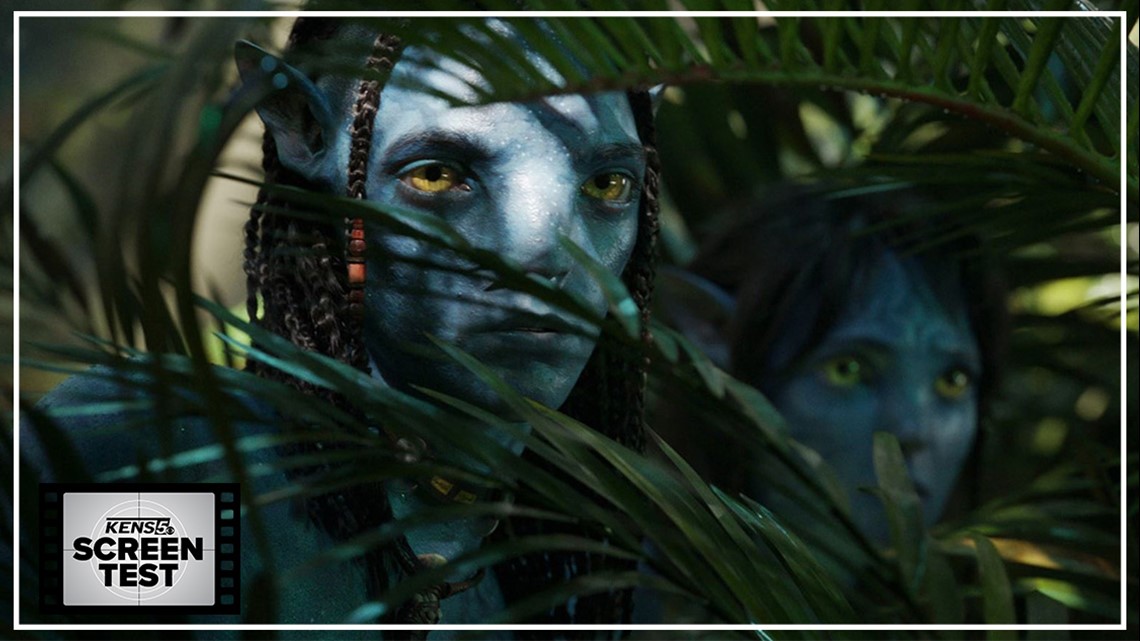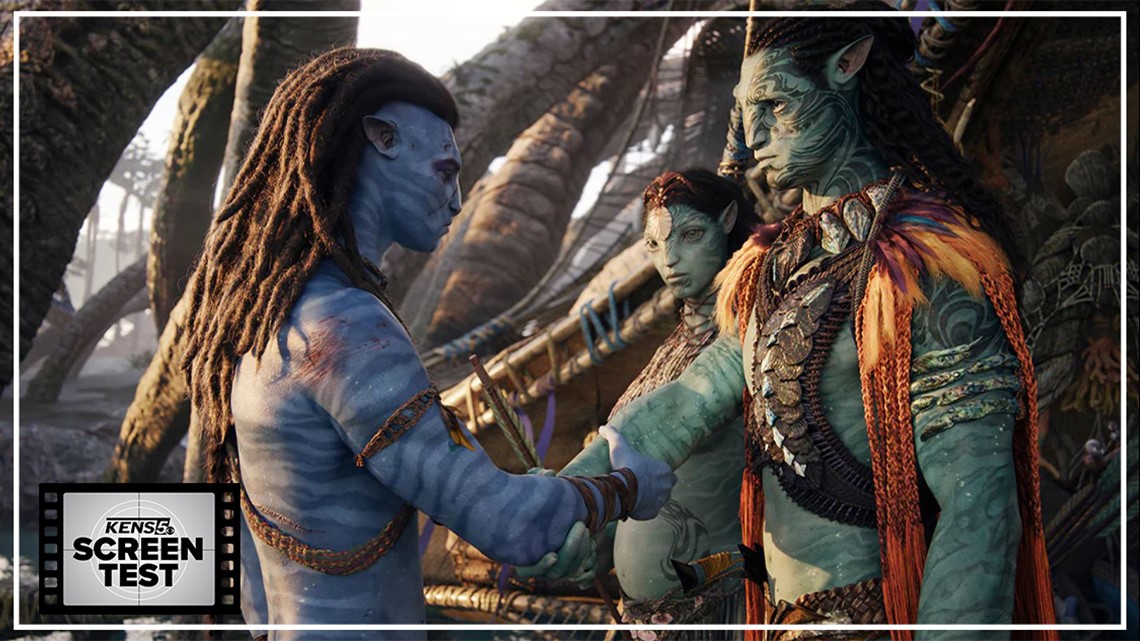TEXAS, USA — When you sit down for a three-hour movie all but certain to be among the most expensive in history, you can bet the price tag has afforded it a certain nimbleness of genre. So it goes that too many of our recent fantasy/action spectaculars (particularly the ones most readily identified by their acronyms) have tended to drag their storytelling weights around like anvils towed on ocean surfaces, crashing against the rocks and struggling to maintain course.
By comparison, “Avatar: The Way of Water” – the years-in-the-making sequel to the biggest box office hit ever, and surely one of the most anticipated movies of all time – is like a skipping stone, its soft tonal ripples gently ensuring the epic scale of Pandora is of a piece with the characters living in it, soaring through it, fighting for it. As he did in 2009, writer/director/industry prophet James Cameron transports us to cinematic places we can hardly believe aren't real, propelled by new leaps in technology and his own sheer chutzpah. But he also largely succeeds in engaging the heart in places where "Avatar" barely managed to keep its head above water.
The movie is, most immediately and most urgently, a war picture. Years after ex-human Jake Sully (Sam Worthington) surrendered to the utopian ways of the blue-skinned Na’vi, the largely militaristic human faction of these movies has returned, no longer operating under the cover of scientific pursuit. They don’t forget easily, less so when it gives them an excuse to set jungles ablaze.
Led by a fully avatar-ized reincarnation of the last film’s villain, Stephen Lang’s ruthless Quaritch (the details of his post-mortem return are murky; the literalization of a colonialism that never dies isn’t), they touch down in an apocalyptic display of smoke and light to reignite conflict with Pandora. Before you’ve fully gotten used to your 3-D glasses, “The Way of Water” is tugging on the cataclysm that it took about 90 minutes for the first film to arrive at. We also get an early sense of the varying degrees of spectacle; an intimate shot of a window reflection was unspeakably dazzling in 3-D, while a subsequent train ambush lacked certain weight.
The brisk reintroduction is nonetheless thrilling, and compels us to buy into what Cameron has been insisting for 13 years: That the first “Avatar” was merely a prologue to what he envisions as a five-film franchise. Its second chapter finds Jake and Neytiri (Zoe Saldana) raising a family when war arrives at their front doorstep – er, tree branch – forcing them to flee to a faraway water colony. Neytiri, whose role has shrunk amid a swath of new characters for us to meet, is hesitant. But Jake’s desperation points at a key thematic evolution from the first film: What does it mean to fight for your home when home is other people?
Cameron, who reportedly spent years just putting his “Avatar” sequels down on the page with a team of other writers, answers the question patiently and by focusing on the “people” part of the equation. Clocking in at a full half-hour longer than its predecessor, “The Way of Water” gives us ample time to soak in the mortar not just of Cameron’s watery world-building but also of its core interpersonal dynamics as the movie shapes into family-relocation drama. Lo’ak (Britain Dalton) restlessly chafes against his father’s strict ways. Kiri is played by Sigourney Weaver, in a curious but not ineffective bit of casting that sees the “Aliens” star motion-capture-performing not only as someone decades her junior, but as a mysterious Christ-like orphan of the human doctor Weaver portrayed in “Avatar.” As the only young human in the family, the feral Spider (Jack Champion) represents another piece of narrative circuitry through which Cameron can at least partially charge some intriguing ideas about identity and belonging.
Those two things come under scrutiny for the entire Sully clan when they arrive at their destination, greeted by a greenish, finned tribe that reluctantly agrees to provide shelter and teach their ways. Here, as in the 2009 movie, we’re asked to make some compromises. Even stones skipping across the water have to plop under at some point. The dialogue is rather hokey. The beats are often predictable. The script conveniently allows for a retreading of material as Jake learns to bond with yet another flying Pandoran species, and though the movie boasts the most graceful use of 3-D I’ve ever seen, budding rivalries between the movie’s adolescent characters lack much dimension of their own. For the second time in as many movies Cameron has essentially grafted well-worn tropes onto his hyperdetailed world, asking that we meet him halfway.
And yet, that burden is a bit easier to carry this time around. Or maybe it’s that, after a glut of comic book adaptations more concerned about winks than wonder, I was more willing to shoulder it—wide-eyed sincerity, cosmic earnestness and all. Amid larger looming threats, our education of this fantastical new corner of Pandora is (hydro)powered by the fresh-faced members of its cast, the stinging familiarity of their growing pains, and the awe-inspiring ways Cameron melds the story and his trademark splendor.
Indeed, the most notable of Jake’s children are themselves avatars of Cameron’s obsession with the natural world and the ways we come into our own through it. Watching Lo’ak form a touching bond with an exiled titan of the ocean or Kiri syncing with the heartbeat of Pandora, you sense his growing confidence in showcasing the spirituality that hung somewhat loosely from the original film’s framework.


Not only is that element of Cameron’s Pandora more potent in this sequel, but it grants us a stable place from which to dive into “The Way of Water” as one of the year’s most convincing love stories—that between the filmmaker himself and water. Do you doubt the romance? This is, after all, the first person to complete a solo voyage into the Mariana Trench. It only makes sense that “The Way of Water” makes history as the first movie to utilize motion-capture technology while its actors are fully underwater, the filmmaker refusing to take any shortcut when it comes down to the actual production.
The result, as you can imagine (and which most people buying a ticket this weekend will expect) are underwater set pieces that are pleasantly sublime to watch on the big screen, and preferably the biggest screen. Rebuking the modern trend that blockbusters need be visually muted to capture imaginations, Cameron’s montages of the Sully clan soaring through Pandora’s seas are vivid and dynamic, the story’s drama adding notes of poetry, the sheer texture and color just shy of staggering. It finally, fully becomes so when Quaritch ultimately catches up to Jake’s family and water goes from graceful surroundings to terrifying force, as if Cameron had been teasing that the director who dramatized Titanic’s doom was no longer with us. That side of the Oscar winner is as formidable as it’s ever been in “The Way of Water,” right down to a showstopper sequences on a massive ship that has become a deathtrap.
That brings us all the way back around to “The Way of Water” as war picture. Not just in the clashes of aliens, mechs and wildlife that dominate what feels like the entire last hour – this gargantuan movie’s high point – but in Cameron waging war on behalf of the environment. Pandora looks even more like a place of dreams given the degradation of our own planet since 2009, but temporary hopes for a made-up planet might no longer be enough for an artist who has long painted with a sincere brush. One sequence in particular is as astoundingly staged as it is incriminatingly rendered, depicting a cruel ocean hunt in set piece that feels purposefully drawn-out, as if to ensure the moral splinter sticks with us after leaving the theater.


The 13 years since “Avatar” have marked an entire epoch for Hollywood, a span of time that’s seen the box office domination of superheroes and dwindling returns for the mid-budget production; a boon for cinematic accessibility and a contrasting crystallization of mainstream audience investment; intellectual property navigated and exploited like an arms race; the ascent of streaming and maybe the early days of its downfall, too.
All of that, in one way or another, factors into how we talk about the legacy of “Avatar,” which many will jump to argue (tellingly bearing a smirk, more often than not) that it hasn’t much of a legacy at all. Whether the 2009 film does or doesn’t have a cultural footprint – a debate that can be twisted any which way regardless – what can’t be denied is that it has massive cultural presence, a self-established mythos that for over a decade has fueled speculation over how Cameron would one-up himself once he ever actually got around to it.
The answer is in the sights and sounds of this return trip to Pandora, yes, but also in a newfound humility with which the journey feels like it’s been crafted with. For years Cameron has broadened the parameters of a director's job, embracing an engineer’s proficiency, an inventor’s passion and a sage’s patience to dazzle audiences anew. More than once has he changed the course of cinema history, not that he’s explicitly set out to do so. But with “The Way of Water” Cameron bends that arc back again, introducing a human element more elegantly shaped than it was in the 2009 original and emboldening that which has increasingly felt perfunctory with ballooning Hollywood budgets.
When our young Na'vi heroes are being taught how to breath underwater, they're told to calm their breathing and slow their heart rate. As he prepares for his next, sure-to-be-bigger "Avatar" excursion, Cameron appears to have embraced that calm. Not for nothing do the combatants in this epic about planetary warfare feel like they stand a little straighter, swing a little harder, cheer a little louder because they take after the filmmaker’s passion, and not just how deep corporate pocketbooks go.
"Avatar: The Way of Water" is rated PG-13 for sequences of strong violence and intense action, partial nudity and some strong language. It opens in theaters Friday. Runtime: Three hours, 12 minutes.
Starring: Sam Worthington, Zoe Saldana, Sigourney Weaver, Stephen Lang
Directed by James Cameron; written by Cameron, Rick Jaffa and Amanda Silver
2022
---
>MORE REVIEWS:



